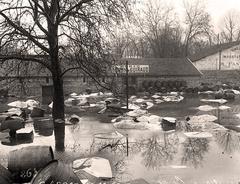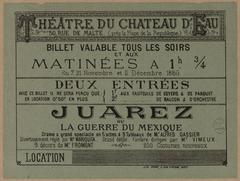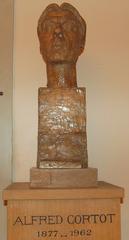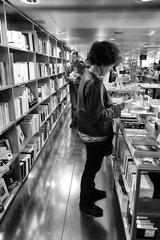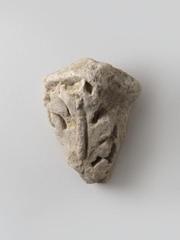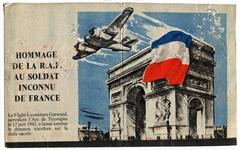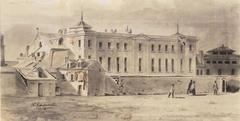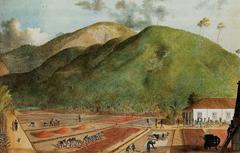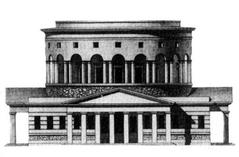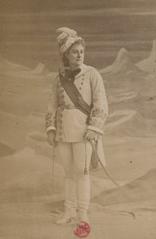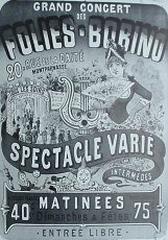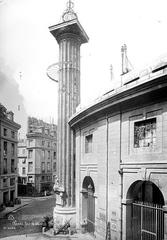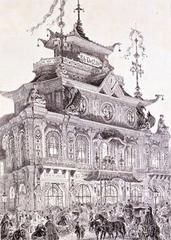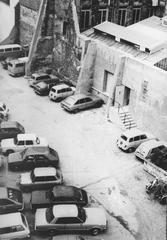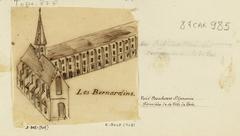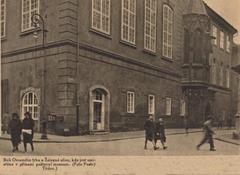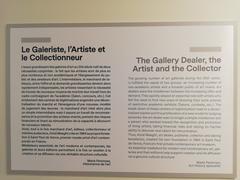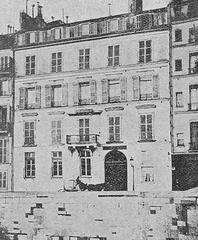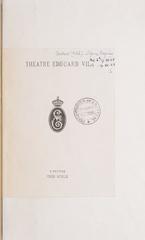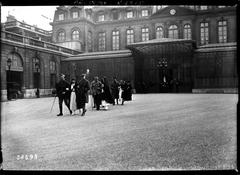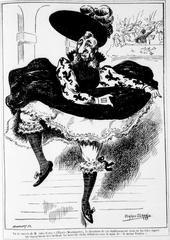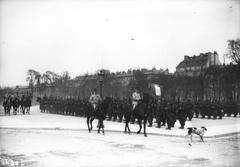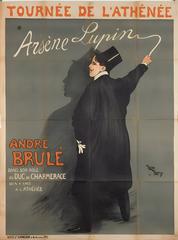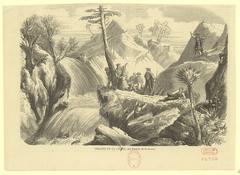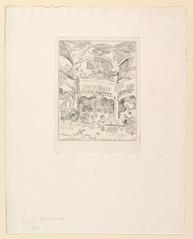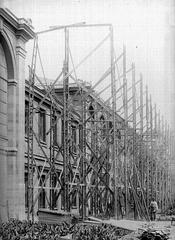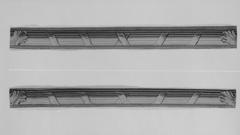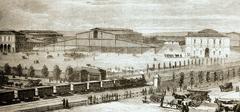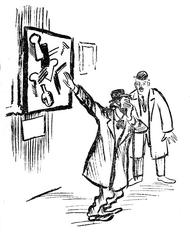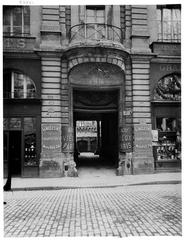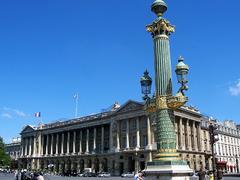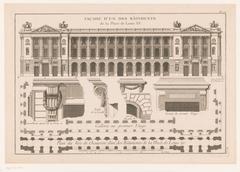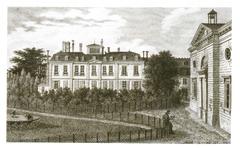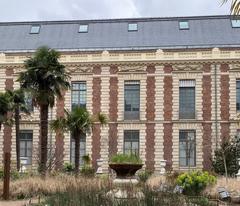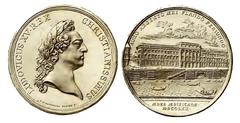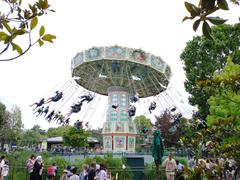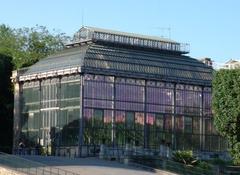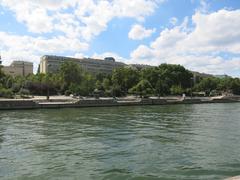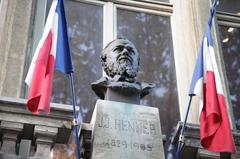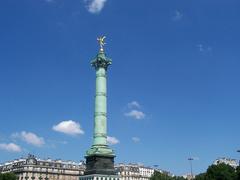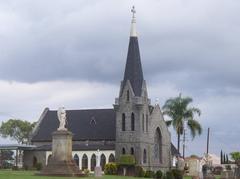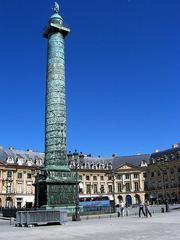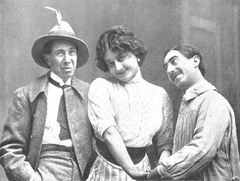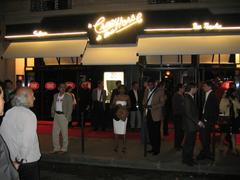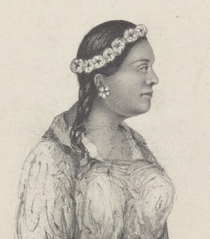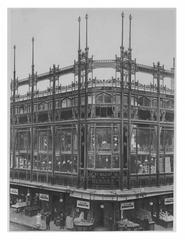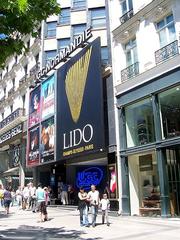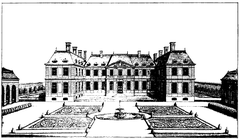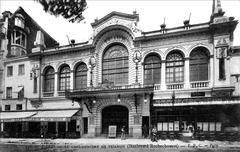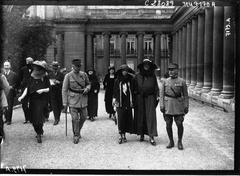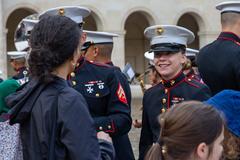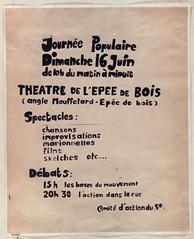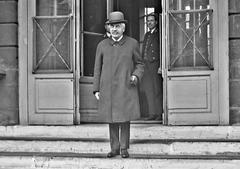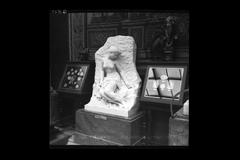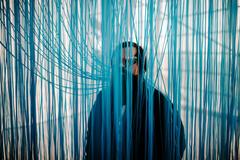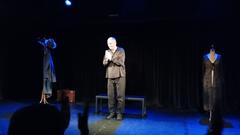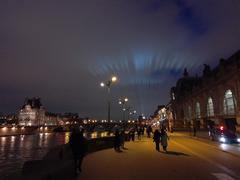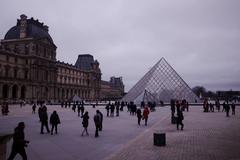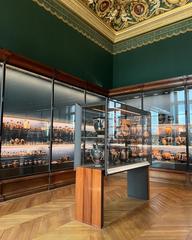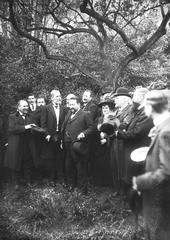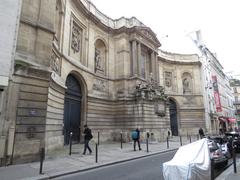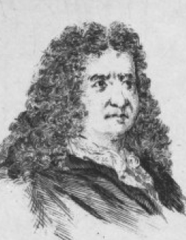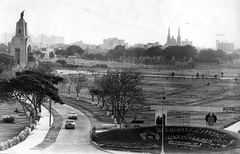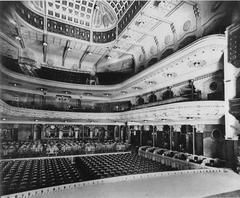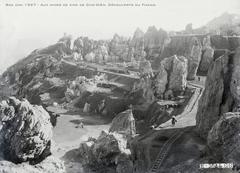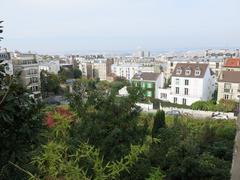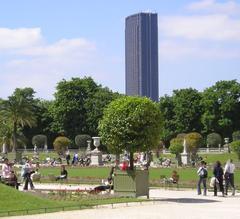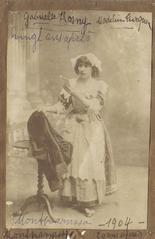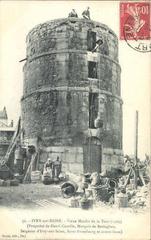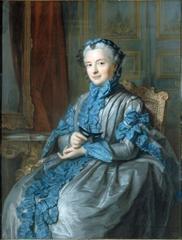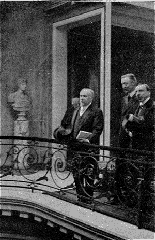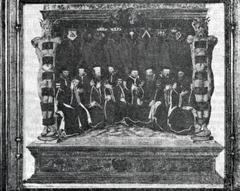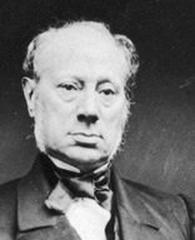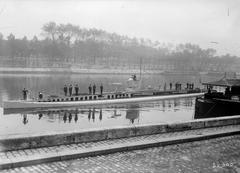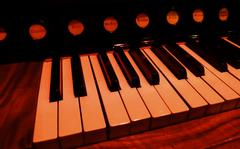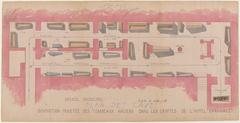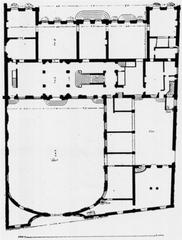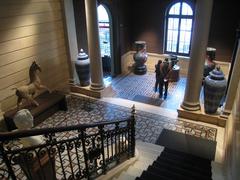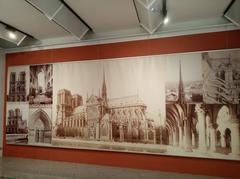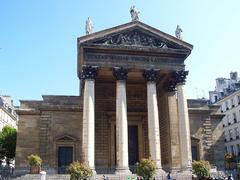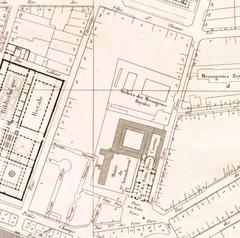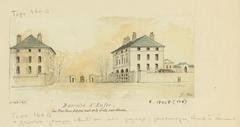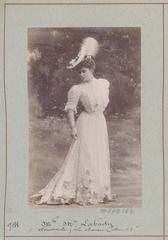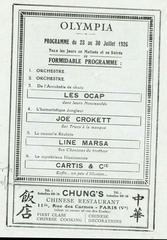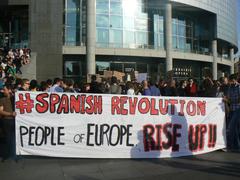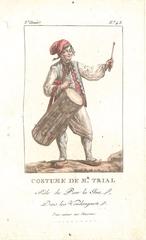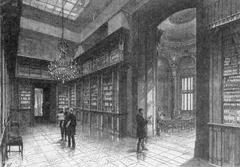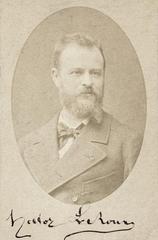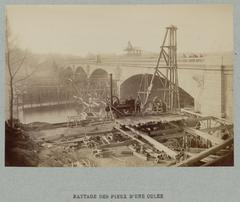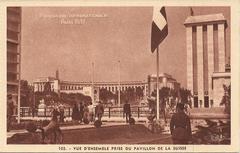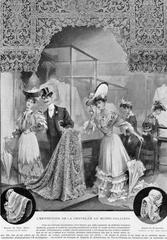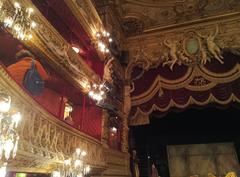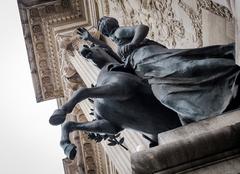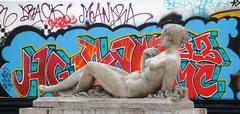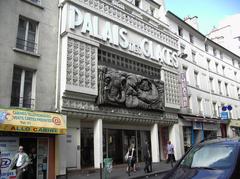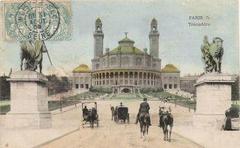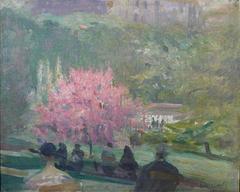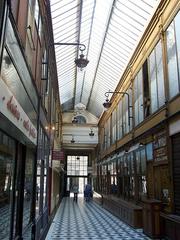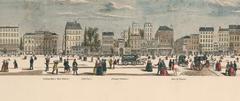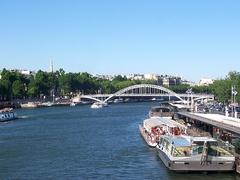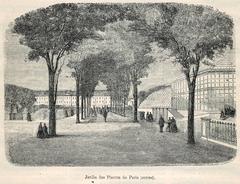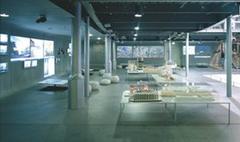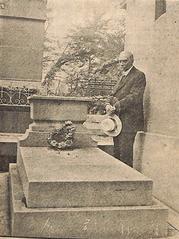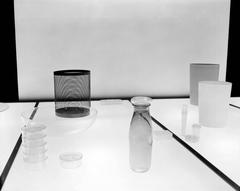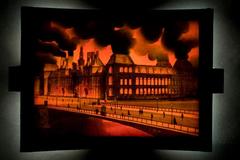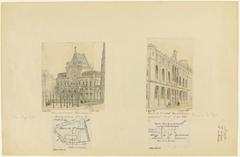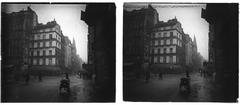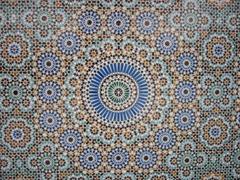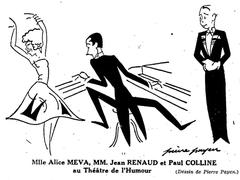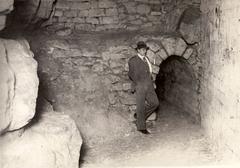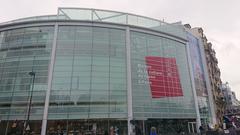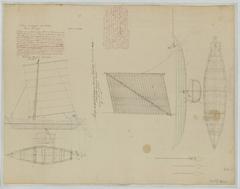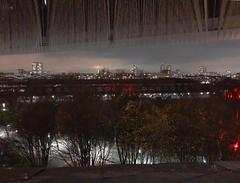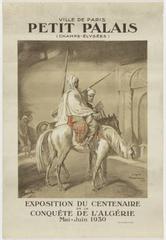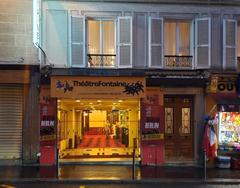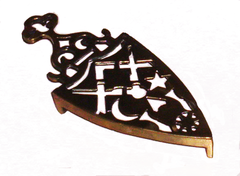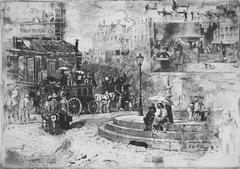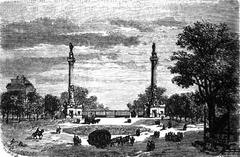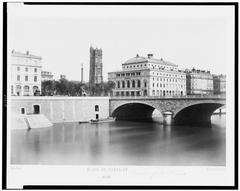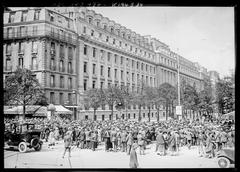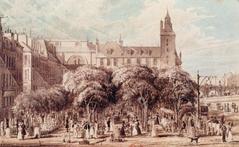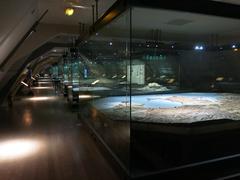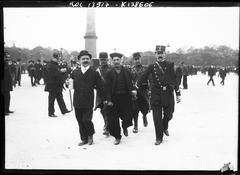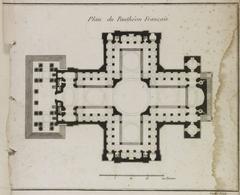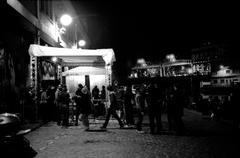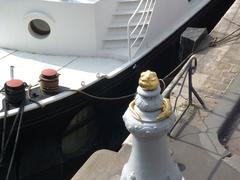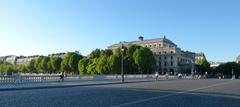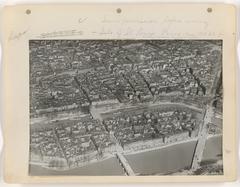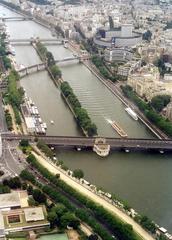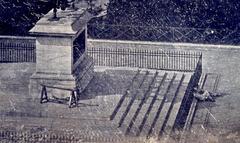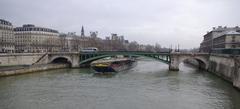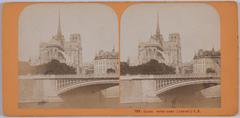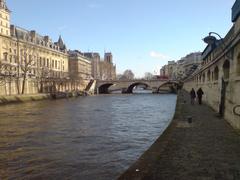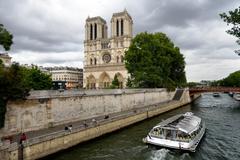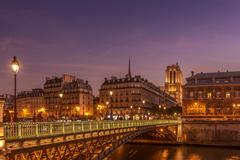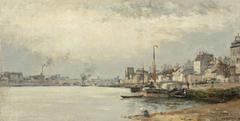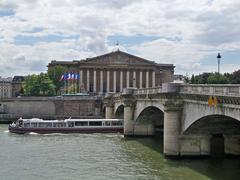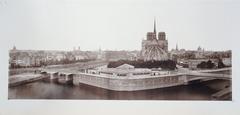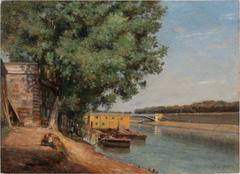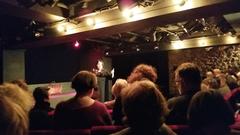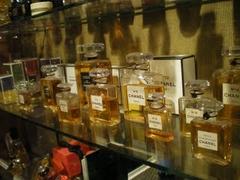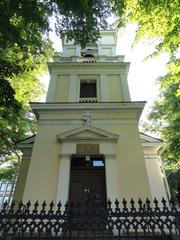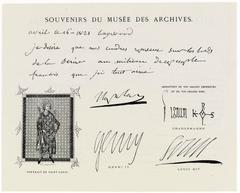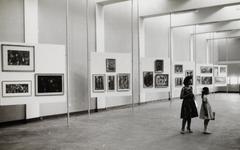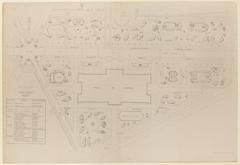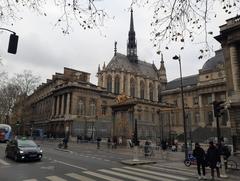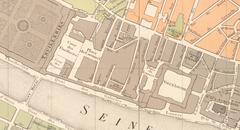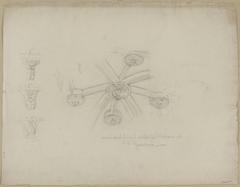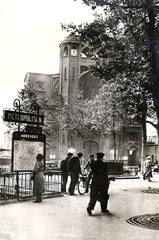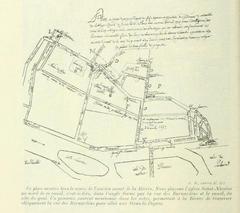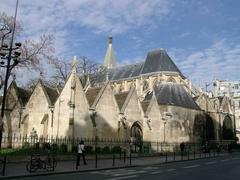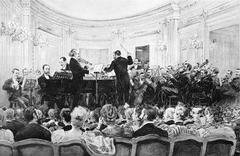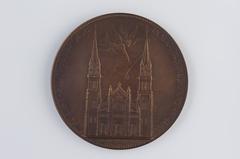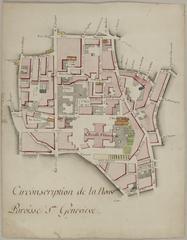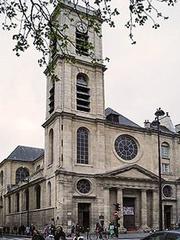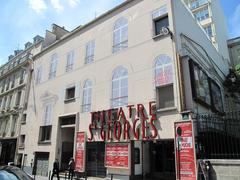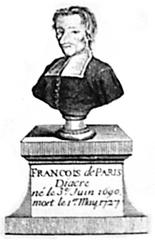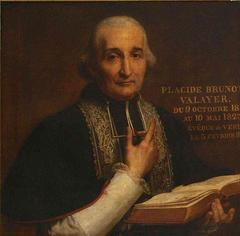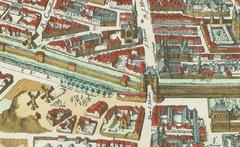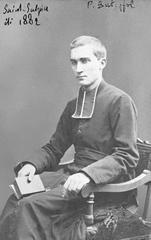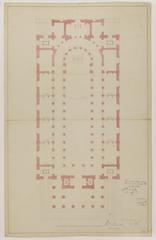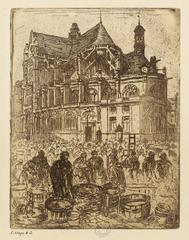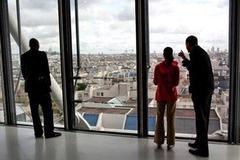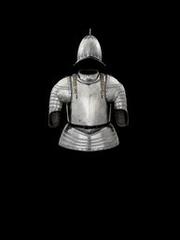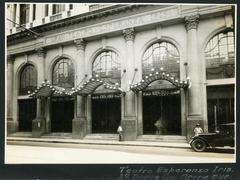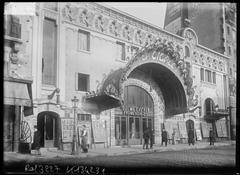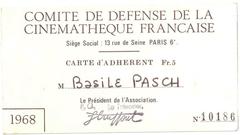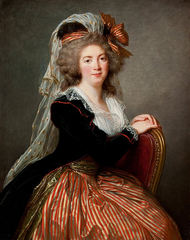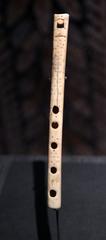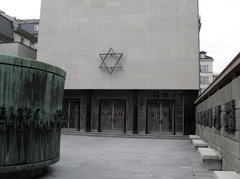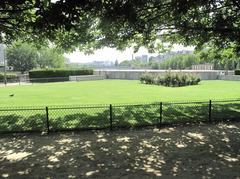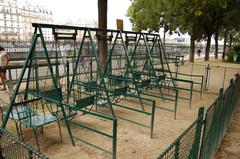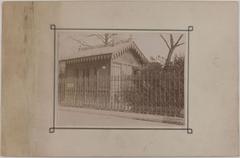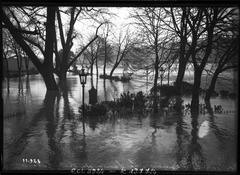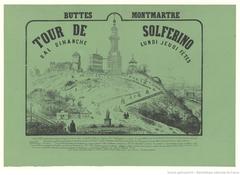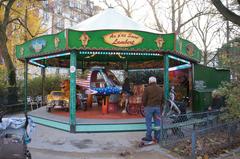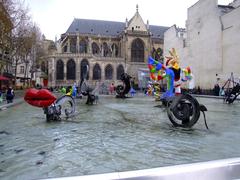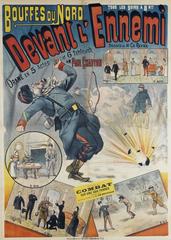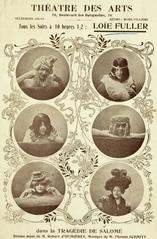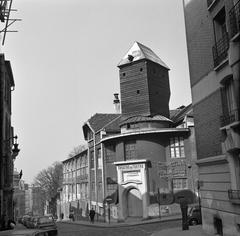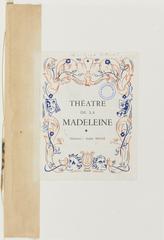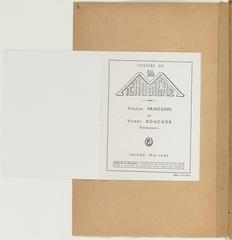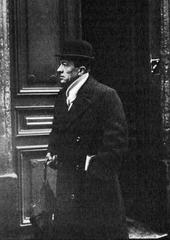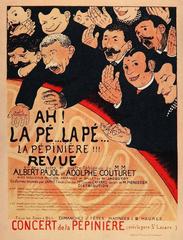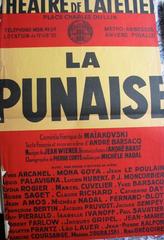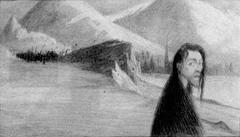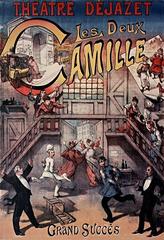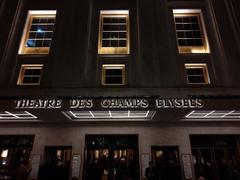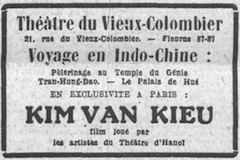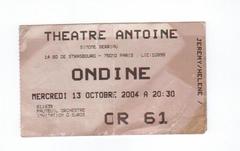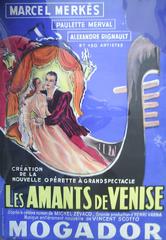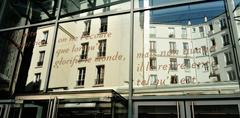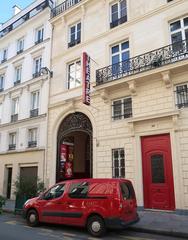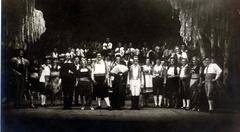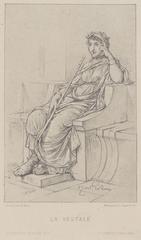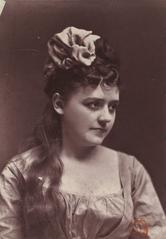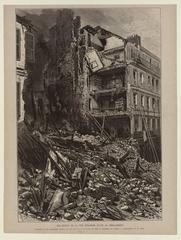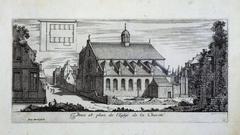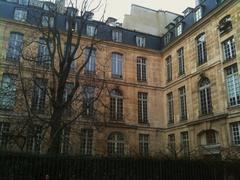
कॉलेज-लाइसि जैक्स-डेकॉर का दौरा करने के लिए संपूर्ण गाइड: पेरिस, फ्रांस
तिथि: 03/07/2025
परिचय
पेरिस के जीवंत 9वें एरॉनडिस्मेंट में स्थित कॉलेज-लाइसि जैक्स-डेकॉर, एक प्रतिष्ठित ऐतिहासिक और शैक्षिक स्थल है। 15वीं सदी के कॉलेज सेंट-बार्बे से अपनी उत्पत्ति का पता लगाते हुए, यह न केवल एक वास्तुशिल्प रत्न है, बल्कि पेरिस की शैक्षणिक और सांस्कृतिक विरासत का एक जीवित स्मारक भी है। यह संपूर्ण गाइड आपको साइट पर जाने के बारे में वह सब कुछ बताता है, जिसमें खुलने का समय, टिकटिंग, पहुंच, आस-पास के आकर्षण और यात्रा सुझाव शामिल हैं, जिससे आप इस पेरिस ऐतिहासिक स्थल पर अपने अनुभव का अधिकतम लाभ उठा सकें।
ऐतिहासिक अवलोकन
उत्पत्ति और प्रारंभिक विकास
15वीं शताब्दी में कॉलेज सेंट-बार्बे के रूप में स्थापित, यह संस्थान पेरिस विश्वविद्यालय से जुड़ा सबसे पुराना फाउंडेशन में से एक है। मूल रूप से लैटिन क्वार्टर में स्थित, इसने सदियों से महत्वपूर्ण रूप से विकसित हुआ, शैक्षणिक सुधारों और पेरिस के बदलते परिदृश्य के अनुकूल ढलते हुए (pia.ac-paris.fr)।
स्थानांतरण और वास्तुशिल्प परिवर्तन
छात्रों की बढ़ती संख्या और पेरिस के आधुनिकीकरण की प्रतिक्रिया में, स्कूल 1867 और 1876 के बीच 12 एवेन्यू ट्रूडेन में अपने वर्तमान स्थान पर स्थानांतरित हो गया। नई साइट में उल्लेखनीय ब्यूक्स-आर्ट्स और शास्त्रीय वास्तुशिल्प तत्व शामिल हैं, जिनमें एक भव्य मुख्य प्रांगण (cour d’honneur), Facchina द्वारा मोज़ाइक, एक घूमने वाले मंच के साथ एक थिएटर और एक आर्ट नोव्यू चैपल शामिल है (lenouveauneuf.fr)।
19वीं और 20वीं सदी का विकास
1919 में लाइसि रोलिन के रूप में और फिर 1944 में लाइसि जैक्स-डेकॉर के रूप में नामित होने के बाद, स्कूल ने विशेष रूप से मानविकी और विज्ञान में शैक्षणिक उत्कृष्टता की प्रतिष्ठा विकसित की। परिसर में एक उल्लेखनीय पुस्तकालय, ऐतिहासिक बस्ट और प्लास्टर कास्ट का एक अनूठा संग्रह है, जो इसकी बौद्धिक और कलात्मक विरासत को दर्शाता है।
द्वितीय विश्व युद्ध और जैक्स-डेकॉर की विरासत
स्कूल जैक्स-डेकॉर (डैनियल डेकॉरडेमांचे) का सम्मान करता है, जो एक प्रोफेसर और फ्रांसीसी प्रतिरोध के नायक थे जिन्हें 1942 में मार दिया गया था। साइट भर में स्मारक - जिसमें होलोकॉस्ट पीड़ितों को याद करने वाली पट्टिकाएं शामिल हैं - स्मरण और मानवतावाद के स्थान के रूप में इसकी भूमिका को रेखांकित करते हैं (pascaltherme.com; sortiraparis.com)।
व्यावहारिक आगंतुक जानकारी
स्थान और पहुंच
- पता: 12 एवेन्यू ट्रूडेन, 75009 पेरिस, फ्रांस
- मेट्रो: एनवर्स (लाइन 2), पिगाल (लाइन्स 2 और 12), या बारबेस-रोशेचUART (लाइन 4)
- बस: लाइनें 30, 54, 67, और 85
- पहुंच: वेलिब’ बाइक स्टेशन और सीमित सड़क पार्किंग पास में हैं, लेकिन सार्वजनिक परिवहन की सलाह दी जाती है (RATP Paris Transport)।
खुलने का समय
कॉलेज-लाइसि जैक्स-डेकॉर मुख्य रूप से एक सक्रिय स्कूल है और नियमित स्कूल के घंटों के दौरान आम तौर पर जनता के लिए बंद रहता है। सार्वजनिक पहुंच आम तौर पर विशेष अवसरों तक सीमित होती है, विशेष रूप से मध्य सितंबर में वार्षिक यूरोपीय विरासत दिवस (Journées du Patrimoine)। 2025 के लिए, स्कूल 20 और 21 सितंबर को आगंतुकों के लिए खुला रहेगा (sortiraparis.com)।
टिकट और आरक्षण
- प्रवेश: विरासत दिवस के दौरान निःशुल्क, उपलब्धता के अधीन
- गाइडेड टूर्स: सीमित क्षमता के कारण गाइडेड टूर्स के लिए आरक्षण आवश्यक है। आधिकारिक वेबसाइट या इवेंट पार्टनर्स (sortiraparis.com) के माध्यम से पहले से बुक करें।
- बाहरी कार्यक्रम: सामान्य पहुंच पूर्व व्यवस्था के साथ समूह यात्राओं या शैक्षिक प्रतिनिधिमंडलों तक सीमित है।
पहुंच
ऐतिहासिक इमारत में सीढ़ियों और सीमित लिफ्ट पहुंच जैसी कुछ गतिशीलता चुनौतियां हैं। सार्वजनिक कार्यक्रमों के दौरान, कभी-कभी अस्थायी रैंप और सुलभ मार्ग प्रदान किए जाते हैं। विकलांग आगंतुकों को उपलब्ध आवासों की पुष्टि करने के लिए पहले से संपर्क करना चाहिए (sortiraparis.com)।
वास्तुशिल्प और सांस्कृतिक मुख्य अंश
भवन और परिसर
1874 और 1876 के बीच निर्मित स्कूल की वास्तुकला ब्यूक्स-आर्ट्स डिजाइन का एक आकर्षक उदाहरण है। मुख्य आकर्षणों में शामिल हैं:
- ग्रैंड पार्लर: अल्फ्रेड लोप-मोंटेल फ्रेस्को के साथ स्वागत कक्ष
- कोर्ट डी’ऑनर: स्मारक पट्टिकाओं और चार्ल्स रोलिन की प्रतिमा के साथ मुख्य प्रांगण
- थिएटर और चैपल: सांस्कृतिक और आध्यात्मिक आयोजनों के लिए अद्वितीय स्थान
- पुस्तकालय और संग्रह: वैज्ञानिक उपकरणों, बस्ट और शैक्षिक कलाकृतियों के प्रदर्शन
- कूरियर डेस मौलाज: कला शिक्षा के लिए उपयोग किए जाने वाले प्लास्टर कास्ट के साथ गलियारा
साइट को आधिकारिक तौर पर एक ऐतिहासिक स्मारक (Monument Historique) के रूप में सूचीबद्ध किया गया है, जो इसके सांस्कृतिक और वास्तुशिल्प महत्व को रेखांकित करता है (Monuments Historiques Paris)।
उल्लेखनीय पूर्व छात्र और विरासत
स्कूल में स्टीफन मैलार्मे, हेनरी बर्गसन, एडौर्ड मैनेट, गुस्ताव मोरो, क्लाउड नूगारो और फ्रांकोइस ट्रफॉट जैसे विद्वान शिक्षक और छात्र रहे हैं (sortiraparis.com; actionbarbes.blogspirit.com)।
सांस्कृतिक प्रोग्रामिंग
विरासत दिवसों और विशेष अवसरों के दौरान, स्कूल संगीत कार्यक्रम, प्रदर्शनियां और शैक्षिक कार्यक्रम आयोजित करता है, जो आगंतुकों को इसकी ऐतिहासिक और सांस्कृतिक महत्व में गहरी अंतर्दृष्टि प्रदान करता है (ac-paris.fr)।
आगंतुक अनुभव
माहौल और समुदाय
लगभग 1,800 छात्रों के साथ, स्कूल वर्ष के दौरान गतिशील और जीवंत होता है। सार्वजनिक यात्राएं एक ऐतिहासिक सेटिंग के भीतर एक जीवंत शैक्षिक वातावरण का अनुभव करने का एक दुर्लभ अवसर प्रदान करती हैं।
सुविधाएं
- शौचालय: सार्वजनिक कार्यक्रमों के दौरान उपलब्ध
- कोट रूम: कार्यक्रम उपस्थित लोगों के लिए प्रदान किया गया
- भोजन: ऑन-साइट कैफे नहीं, लेकिन आस-पास के पड़ोस में पर्याप्त भोजन विकल्प
फोटोग्राफी
- बाहरी: सार्वजनिक फुटपाथों से फोटोग्राफी की अनुमति है
- आंतरिक: निर्देशित पर्यटन के दौरान गाइड की मंजूरी के साथ निर्दिष्ट क्षेत्रों में अनुमति है; आम तौर पर नियमित स्कूल घंटों या सार्वजनिक कार्यक्रमों के बाहर प्रतिबंधित है
भाषा
फ्रांसीसी मुख्य भाषा है। कुछ गाइड सार्वजनिक कार्यक्रमों के दौरान मूल अंग्रेजी स्पष्टीकरण दे सकते हैं, लेकिन यह गारंटीकृत नहीं है। गैर-फ्रांसीसी बोलने वालों के लिए अनुवाद ऐप या वाक्यांशपुस्तिकाएं अनुशंसित हैं।
आस-पास के आकर्षण
- मॉन्टमार्ट्रे: कलात्मक क्वार्टर और सेक्रे-कोeur बेसिलिका 10 मिनट से भी कम दूरी पर
- बुलेवार्ड डी रोचेचuart: थिएटर और संगीत स्थल
- स्क्वायर डी’एनवर्स: सार्वजनिक सुविधाओं वाला हरा-भरा स्थान
- प्लेस पिगाल: ऐतिहासिक नाइटलाइफ़ जिला
- स्थानीय कैफे और रेस्तरां: आस-पास प्रचुर विकल्प (parisdiscoveryguide.com)
यात्रा सुझाव
- आगे की योजना बनाएं: सार्वजनिक पहुंच दुर्लभ और कार्यक्रम-आधारित है। अपडेट के लिए आधिकारिक वेबसाइट पर नज़र रखें।
- जल्दी बुक करें: गाइडेड टूर्स के लिए जल्दी आरक्षण करें क्योंकि स्थान जल्दी भर जाते हैं।
- आरामदायक कपड़े पहनें: चलने और सीढ़ियाँ चढ़ने की अपेक्षा करें।
- पर्यावरण का सम्मान करें: सभी आगंतुक दिशानिर्देशों का पालन करें।
- यात्राओं को मिलाएं: अपने दौरे से पहले या बाद में मॉन्टमार्ट्रे का अन्वेषण करें या स्थानीय कैफे का आनंद लें।
अक्सर पूछे जाने वाले प्रश्न (FAQ)
प्रश्न: क्या मैं कॉलेज-लाइसि जैक्स-डेकॉर वर्ष भर जा सकता हूँ? ए: सार्वजनिक यात्राएं यूरोपीय विरासत दिवसों या समूह पर्यटन के लिए पूर्व व्यवस्था के रूप में विशेष अवसरों तक सीमित हैं।
प्रश्न: क्या टिकट आवश्यक हैं? ए: सार्वजनिक कार्यक्रमों के दौरान प्रवेश निःशुल्क है, लेकिन गाइडेड टूर्स के लिए अग्रिम आरक्षण की आवश्यकता होती है।
प्रश्न: क्या साइट विकलांग आगंतुकों के लिए सुलभ है? ए: कुछ क्षेत्रों तक पहुंचना चुनौतीपूर्ण है; विशेष आवासों के लिए स्कूल से संपर्क करें।
प्रश्न: क्या मैं अंदर तस्वीरें ले सकता हूँ? ए: फोटोग्राफी आम तौर पर बाहरी क्षेत्रों और पर्यटन के दौरान निर्दिष्ट क्षेत्रों में अनुमत है।
प्रश्न: आस-पास और क्या देखा जा सकता है? ए: मॉन्टमार्ट्रे, सेक्रे-कोeur, स्थानीय थिएटर और कई कैफे सभी पैदल दूरी पर हैं।
संपर्क जानकारी
- पता: 12 एवेन्यू ट्रूडेन, 75009 पेरिस, फ्रांस
- फोन: +33 1 48 78 10 86
- वेबसाइट: कॉलेज-लाइसि जैक्स-डेकॉर
- ईमेल: आधिकारिक वेबसाइट पर संपर्क फ़ॉर्म के माध्यम से
सारांश और अंतिम सिफारिशें
कॉलेज-लाइसि जैक्स-डेकॉर शैक्षिक उत्कृष्टता, वास्तुशिल्प भव्यता और ऐतिहासिक स्मरण के चौराहे पर खड़ा है। 15वीं सदी के कॉलेज सेंट-बार्बे से लेकर द्वितीय विश्व युद्ध की स्मृति में इसकी महत्वपूर्ण भूमिका तक, इसकी समृद्ध विरासत पेरिस ऐतिहासिक स्थलों में रुचि रखने वालों के लिए इसे अवश्य देखना चाहिए। विशेष आयोजनों के आसपास अपनी यात्रा की योजना बनाएं, अपना स्थान पहले से आरक्षित करें, और पेरिस के कलात्मक और सांस्कृतिक हृदय का पता लगाने के लिए इसके केंद्रीय स्थान का लाभ उठाएं (pascaltherme.com; pia.ac-paris.fr; sortiraparis.com; parisdiscoveryguide.com)।
खुलने के समय, टिकटिंग और कार्यक्रमों पर सबसे अद्यतित जानकारी के लिए, ऑडियल ऐप डाउनलोड करें और पेरिस की विरासत चैनलों का पालन करें। पेरिस की शैक्षणिक संस्कृति के हृदय में आपकी यात्रा की प्रतीक्षा है।
स्रोत
ऑडियल2024{‘date’: ‘03/07/2025’, ‘task’: {‘model’: ‘gpt-4.1-mini’, ‘query’: ‘Comprehensive guide to visiting Collège-Lycée Jacques-Decour, Paris, France: history, significance, visitor tips, and everything tourists need to know for a memorable experience.’, ‘verbose’: False, ‘guidelines’: [“Keyword Research: Identify relevant keywords that potential visitors are likely to search for, such as ‘[Monument Name] visiting hours,’ ‘[Monument Name] tickets,’ and ‘[City] historical sites.’ Use these keywords strategically throughout the article, including in the title, headers, and body text, but avoid keyword stuffing.”, ‘Engaging and Informative Title: Craft a title that is both SEO-friendly and compelling to encourage clicks. Include the main keyword and make it clear what the article will cover.’, ‘Structured Content: Use headings (H1, H2, H3) to organize the content effectively. This helps with SEO and makes the article easier for readers to navigate. Include an introduction that hooks the reader, a detailed body that covers all relevant aspects, and a conclusion that summarizes the key points.’, ‘Comprehensive Coverage: Address common questions and topics of interest such as the history of the monument, its cultural significance, visitor information (e.g., ticket prices, opening hours), travel tips, nearby attractions, and accessibility. Include sections that might be unique to the monument, like special events, guided tours, and photographic spots.’, ‘Quality Content: Ensure the content is well-researched, accurate, and provides real value to readers. Use reliable sources and provide factual information. Write in a clear, engaging, and accessible style. Consider your audience and use language that is appropriate for those likely to visit the monument.’, ‘Visuals and Media: Incorporate high-quality images or videos of the monument. These should be optimized for the web (correct sizing, alt tags with keywords). Consider interactive elements like virtual tours or maps.’, ‘Internal and External Links: Include links to other related articles on your site to encourage deeper engagement (internal links). Link to official websites for the monument or credible sources for further reading (external links).’, ‘FAQ: Incorporate FAQ sections to target voice search queries and featured snippets’, ‘Visit and Stay Up to Date: End the article with a call to action, such as encouraging readers to download our mobile app Audiala, check out other related posts, or follow on social media for more updates.’], ‘max_sections’: 4, ‘publish_formats’: {‘pdf’: False, ‘docx’: False, ‘markdown’: True}, ‘follow_guidelines’: True}, ‘title’: ‘Comprehensive Guide to Visiting Collège-Lycée Jacques-Decour, Paris, France’, ‘report’: ’# Complete Guide to Collège-Lycée Jacques-Decour: Visiting Hours, Tickets, and Exploring Paris Historical Sites\n\n#### Date: 03/07/2025\n\n---\n\n## Introduction\n\nCollège-Lycée Jacques-Decour, located in the lively 9th arrondissement of Paris, is a distinguished historical and educational landmark. With origins tracing back to the 15th-century Collège Sainte-Barbe, it is not only an architectural gem but also a living memorial to Paris’s academic and cultural legacy. This comprehensive guide covers everything you need to know about visiting the site, including opening hours, ticketing, accessibility, nearby attractions, and travel tips, ensuring you make the most of your experience at this Paris historical site.\n\n---\n\n## Historical Overview\n\n### Origins and Early Development\n\nFounded as Collège Sainte-Barbe in the 15th century, the institution is one of the oldest foundations connected to the University of Paris. Initially located in the Latin Quarter, it evolved significantly over the centuries, adapting to academic reforms and the changing landscape of Paris (pia.ac-paris.fr).\n\n### Relocation and Architectural Transformation\n\nIn response to a growing student body and the modernization of Paris, the school moved to its current location at 12 Avenue Trudaine between 1867 and 1876. The new site features remarkable Beaux-Arts and classical architectural elements, including a grand cour d’honneur, mosaics by Facchina, a theater with a revolving stage, and an Art Nouveau chapel (lenouveauneuf.fr).\n\n### 19th and 20th Century Evolution\n\nHaving been renamed Lycée Rollin in 1919 and then Lycée Jacques-Decour in 1944, the school developed a reputation for academic excellence, particularly in the humanities and sciences. The campus houses a notable library, historic busts, and a unique collection of plaster casts, reflecting its intellectual and artistic heritage.\n\n### World War II and the Legacy of Jacques Decour\n\nThe school honors Daniel Decourdemanche (known as Jacques Decour), a professor and French Resistance hero executed in 1942. Memorials throughout the site—including plaques commemorating Holocaust victims—underscore its role as a place of remembrance and humanism (pascaltherme.com; sortiraparis.com).\n\n---\n\n## Practical Visitor Information\n\n### Location and Getting There\n\n- Address: 12 Avenue Trudaine, 75009 Paris, France\n- Metro: Anvers (Line 2), Pigalle (Lines 2 & 12), or Barbès-Rochechouart (Line 4)\n- Bus: Lines 30, 54, 67, and 85\n- Accessibility: Vélib’ bike stations and limited street parking are nearby, but public transport is recommended (RATP Paris Transport).\n\n### Visiting Hours\n\nCollège-Lycée Jacques-Decour is primarily an active school and is generally closed to the public during regular school hours. Public access is typically limited to special occasions, most notably the annual European Heritage Days (Journées du Patrimoine) in mid-September. For 2025, the school will be open to visitors on September 20th and 21st (sortiraparis.com).\n\n### Tickets and Reservations\n\n- Entry: Free during Heritage Days, subject to availability\n- Guided Tours: Reservations are required for guided tours due to limited capacity. Book in advance via the official website or event partners (sortiraparis.com).\n- Outside Events: General access is limited to group visits or educational delegations with prior arrangement.\n\n### Accessibility\n\nThe historic building presents some mobility challenges, such as staircases and limited elevator access. During public events, temporary ramps and accessible routes are sometimes provided. Visitors with disabilities should contact the administration in advance to confirm available accommodations (sortiraparis.com).\n\n---\n\n## Architectural and Cultural Highlights\n\n### Building and Grounds\n\nThe school’s architecture, completed between 1874 and 1876, is a striking example of Beaux-Arts design. Highlights include:\n- Grand Parloir: Reception room featuring an Alfred Lop-Montel fresco\n- Cour d’Honneur: Main courtyard with commemorative plaques and a statue of Charles Rollin\n- Theater and Chapel: Unique spaces for cultural and spiritual events\n- Library and Collections: Displays of scientific instruments, busts, and educational art pieces\n- Couloir des moulages: Corridor with plaster casts used for art education\n\nThe site is officially listed as a Monument Historique, underscoring its cultural and architectural importance (Monuments Historiques Paris).\n\n### Notable Alumni and Legacy\n\nThe school has counted among its teachers and students luminaries such as Stéphane Mallarmé, Henri Bergson, Édouard Manet, Gustave Moreau, Claude Nougaro, and François Truffaut (sortiraparis.com; actionbarbes.blogspirit.com).\n\n### Cultural Programming\n\nDuring Heritage Days and special occasions, the school hosts concerts, exhibitions, and educational events, offering visitors deeper insight into its historic and cultural significance (ac-paris.fr).\n\n---\n\n## Visitor Experience\n\n### Atmosphere and Community\n\nWith approximately 1,800 students, the campus is dynamic and lively during the school year. Public visits offer a rare chance to experience a vibrant educational environment within a historic setting.\n\n### Amenities\n\n- Restrooms: Available during public events\n- Cloakrooms: Provided for event attendees\n- Food: No on-site cafés, but ample dining options in the surrounding neighborhood\n\n### Photography\n\n- Exteriors: Photography is permitted from public sidewalks\n- Interiors: Allowed in designated areas during tours with guide approval; generally restricted during regular school hours or outside public events\n\n### Language\n\nFrench is the primary language spoken. Some guides may offer basic English explanations during public events, but this is not guaranteed. Translation apps or phrasebooks are recommended for non-French speakers.\n\n---\n\n## Nearby Attractions\n\n- Montmartre: Artistic quarter and Sacré-Cœur Basilica less than 10 minutes away\n- Boulevard de Rochechouart: Theaters and music venues\n- Square d’Anvers: Green space with public facilities\n- Place Pigalle: Historic nightlife district\n- Local cafés and restaurants: Abundant options nearby (parisdiscoveryguide.com)\n\n---\n\n## Travel Tips\n\n- Plan Ahead: Public access is rare and event-based. Monitor the official website for updates.\n- Book Early: Reserve guided tours as spots fill quickly.\n- Dress Comfortably: Expect to walk and climb stairs.\n- Respect the Environment: Follow all visitor guidelines.\n- Combine Visits: Explore Montmartre or enjoy a local café before or after your tour.\n\n---\n\n## Frequently Asked Questions (FAQ)\n\nQ: Can I visit Collège-Lycée Jacques-Decour year-round? \nA: Public visits are limited to special events like European Heritage Days or by prior arrangement for group tours.\n\nQ: Are tickets required? \nA: Entry during public events is free, but guided tours require advance reservations.\n\nQ: Is the site accessible to visitors with disabilities? \nA: Some areas are challenging to access; contact the school for specific accommodations.\n\nQ: Can I take photos inside? \nA: Photography is generally allowed in exteriors and designated areas during tours.\n\nQ: What else can I see nearby? \nA: Montmartre, Sacré-Cœur, local theaters, and numerous cafés are all within walking distance.\n\n---\n\n## Contact Information\n\n- Address: 12 Avenue Trudaine, 75009 Paris, France\n- Phone: +33 1 48 78 10 86\n- Website: Collège-Lycée Jacques-Decour\n- Email: Via the contact form on the official website\n\n---\n\n## Summary and Final Recommendations\n\nCollège-Lycée Jacques-Decour stands at the crossroads of educational excellence, architectural grandeur, and historical remembrance. Its rich legacy—from the 15th-century Collège Sainte-Barbe to its pivotal role in WWII memory—makes it a must-visit for those interested in Paris historical sites. Plan your visit around special events, reserve your spot in advance, and take advantage of its central location to explore the artistic and cultural heart of Paris (pascaltherme.com; pia.ac-paris.fr; sortiraparis.com; parisdiscoveryguide.com).\n\nFor the most up-to-date information on visiting hours, ticketing, and events, download the Audiala app and follow official Paris heritage channels. Your journey into the heart of Parisian academic culture awaits.\n\n---\n\n## Sources\n\n- pia.ac-paris.fr\n- pascaltherme.com\n- sortiraparis.com\n- ac-paris.fr\n- parisdiscoveryguide.com\n\n---\n\n’, ‘headers’: {‘date’: ‘Date’, ‘title’: ‘Complete Guide to Collège-Lycée Jacques-Decour Visiting Hours Tickets and Paris Historical Sites’, ‘conclusion’: ‘Summary and Final Tips for Visiting Collège-Lycée Jacques-Decour’, ‘references’: ‘Sources and Official Links for Collège-Lycée Jacques-Decour’, ‘introduction’: ‘Introduction to Collège-Lycée Jacques-Decour and its significance in Paris’, ‘table_of_contents’: ‘Overview History Cultural Significance Visiting Information Tickets and Hours Travel Tips Nearby Attractions Accessibility Special Events Guided Tours Photographic Spots FAQ’}, ‘sources’: [’- Exploring Collège-Lycée Jacques-Decour: A Historic Parisian Landmark Worth Visiting, 2024, pia.ac-paris.fr https://pia.ac-paris.fr/serail/jcms/s2_3324795/fr/presentation-de-la-cite-scolaire’, ’- Lycée Jacques-Decour Visiting Hours, Tickets & Paris Historical Sites: Architectural and Cultural Guide, 2024, pascaltherme.com https://pascaltherme.com/portfolio/lycee-jacques-decour-2/’, ’- Collège-Lycée Jacques-Decour Visiting Hours and Tickets: A Guide to Exploring This Paris Historical Site, 2025, sortiraparis.com https://www.sortiraparis.com/en/news/heritage-days/articles/299021-heritage-days-2025-visit-the-magnificent-lycee-jacques-decour-9th-arrondissement’, ’- Visiting Collège-Lycée Jacques-Decour: Hours, History, Tickets, and Nearby Attractions in Paris, 2025, ac-paris.fr https://www.ac-paris.fr/etablissements/college-lycee-jacques-decour’, ’- Paris Discovery Guide: Montmartre, 2024, parisdiscoveryguide.com https://www.parisdiscoveryguide.com/montmartre.html’], ‘sections’: [‘Historical Overview’, ‘Architectural and Cultural Significance’, ‘Visitor Experience’, ‘Practical Information’], ‘conclusion’: ‘Collège-Lycée Jacques-Decour embodies a remarkable fusion of educational excellence, architectural splendor, and poignant historical memory in the heart of Paris. Its roots stretching back to the 15th century and architectural presence from the late 19th century offer visitors an immersive journey into France’s rich academic and cultural traditions. The school’s dedication to preserving the legacy of Jacques Decour and its Holocaust victims underlines its role as a living memorial of resistance, humanism, and remembrance (pascaltherme.com; pia.ac-paris.fr).\n\nAlthough public visitation is limited primarily to special events such as the European Heritage Days, these occasions offer invaluable access to explore its grand courtyards, historic theater, chapel, and curated collections. The school’s location near Montmartre and Sacré-Cœur makes it an ideal cultural stop on any Paris itinerary, allowing visitors to combine educational heritage with the city’s vibrant artistic scene (sortiraparis.com; parisdiscoveryguide.com).\n\nFor those planning a visit, early reservation for guided tours is recommended due to limited capacity and accessibility considerations. Photography is generally permitted in exterior areas, with interior permissions granted selectively to respect the ongoing educational environment. Staying informed through the official school website and trusted Paris tourism sources will ensure a seamless and rewarding experience.\n\nTo stay updated on visiting hours, ticket availability, and cultural events at Collège-Lycée Jacques-Decour, visitors are encouraged to download the Audiala mobile app and follow social media channels dedicated to Paris’s historical sites. By doing so, you will unlock richer insights and exclusive content that enhance your understanding and enjoyment of one of Paris’s most treasured educational landmarks (Audiala app, ac-paris.fr). Your journey into the heart of Parisian academic heritage and cultural memory awaits.’, ‘introduction’: ‘Nestled in the vibrant 9th arrondissement of Paris, Collège-Lycée Jacques-Decour stands as a distinguished historical and educational landmark that beautifully encapsulates centuries of Parisian academic tradition and cultural heritage. Originating from the 15th-century Collège Sainte-Barbe, one of the oldest foundations linked to the University of Paris, it has evolved through several transformations, notably relocating in the late 19th century to its current site at 12 Avenue Trudaine. The school’s architecture is a compelling blend of classical and Beaux-Arts styles, featuring ornate facades, elegant courtyards, and unique spaces such as a theater with a rotating stage and an Art Nouveau chapel, reflecting both its educational purpose and artistic legacy (pia.ac-paris.fr; pascaltherme.com).\n\nBeyond its architectural grandeur, Collège-Lycée Jacques-Decour is deeply intertwined with Parisian history, serving as a living memorial to Daniel Decourdemanche (Jacques Decour), a professor and French Resistance hero executed during World War II. The institution commemorates its past students and faculty, including those who perished in the Holocaust, through plaques and cultural events, thus offering visitors an enriching experience that melds education, remembrance, and cultural identity (pascaltherme.com; sortiraparis.com).\n\nWhile the school functions primarily as an active educational institution with approximately 1,700 students, public access is thoughtfully managed. Visitors can explore the historic site during special occasions such as the European Heritage Days, when guided tours unveil the school’s architectural treasures, cultural collections, and historic courtyards. Its proximity to the artistic Montmartre district and iconic landmarks like Sacré-Cœur further enriches the visitor experience with abundant sightseeing and photographic opportunities (ac-paris.fr; parisdiscoveryguide.com).\n\nThis comprehensive guide will provide detailed insights on Collège-Lycée Jacques-Decour visiting hours, ticketing, accessibility, and nearby attractions, equipping both history aficionados and casual travelers with all the necessary information to appreciate this Paris historical site fully.’, ‘research_data’: [{‘Exploring Collège-Lycée Jacques-Decour: A Historic Parisian Landmark Worth Visiting’: ’## Introduction\n\nNestled in the heart of Paris’s 9th arrondissement, Collège-Lycée Jacques-Decour is a remarkable historical and educational monument that offers visitors a unique glimpse into the city’s rich academic and cultural heritage. This article guides you through the origins, architectural splendor, and meaningful legacy of Jacques-Decour, while also providing essential visitor information such as visiting hours, location, accessibility, and tips to help you plan your visit.\n\n## Origins and Early Development\n\nThe Collège-Lycée Jacques-Decour traces its roots back to the venerable Collège Sainte-Barbe, founded in the 15th century under the University of Paris. Originally established in the Latin Quarter near the Sorbonne, it evolved over centuries, with significant reforms and name changes reflecting its deep academic traditions (pia.ac-paris.fr).\n\n## Relocation and Architectural Transformation\n\nBetween 1867 and 1876, to accommodate a growing student body and a modernizing Paris, the school was relocated to 12 avenue Trudaine on the site of the former Montmartre abattoirs. The new campus features an elegant blend of classical and innovative 19th-century architecture, including a verdant cour d’honneur, decorative mosaics by the Italian artist Facchina, a distinctive theater with a rotating stage, and a chapel with floral Art Nouveau stained glass (lenouveauneuf.fr).\n\n## Evolution Through the 19th and 20th Centuries\n\nThe institution, renamed Lycée Rollin in 1919 and later Lycée Jacques-Decour in 1944, developed a reputation for academic excellence, especially in humanities and sciences. Its library, historic busts, and plaster casts reflect a longstanding dedication to arts and scholarship.\n\n## The Second World War and the Legacy of Jacques Decour\n\nThe school’s name honors Jacques Decour (Daniel Decourdemanche), a heroic professor and French Resistance member executed in 1942. The lycée also commemorates its Jewish students who were victims of the Holocaust, with a memorial plaque unveiled in 2009 in the presence of Simone Veil.\n\n## Visiting Collège-Lycée Jacques-Decour: Practical Information\n\n### Location and Getting There\nCollège-Lycée Jacques-Decour is located at 12 avenue Trudaine, 75009 Paris. It is easily reachable via Paris Métro lines 2 and 12 (stations Pigalle and Notre-Dame-de-Lorette) and by several bus routes.\n\n### Visiting Hours and Tickets\nThe school is primarily an educational institution; therefore, public access is limited. However, guided tours and special events are occasionally offered, especially during European Heritage Days. Visitors are encouraged to check the official Paris Education Authority website or contact the school’s administration for updated visiting hours and ticket information.\n\n### Accessibility\nThe site is partially accessible to visitors with reduced mobility. It is advisable to inquire in advance about specific accommodations.\n\n### Guided Tours and Special Events\nGuided tours focusing on the school’s architecture, history, and cultural heritage are organized periodically. The theater and chapel sometimes host performances and concerts open to the public.\n\n## Nearby Attractions and Photographic Spots\n\nSituated near Montmartre, visitors can combine a visit to Jacques-Decour with a stroll through the vibrant district known for the Sacré-Cœur Basilica, lively cafés, and artist studios. The school’s cour d’honneur and theater facade provide excellent photographic opportunities, especially in spring and autumn.\n\n## Architectural and Cultural Heritage\n\nThe campus serves as a living museum of 19th-century Parisian educational architecture. From the mansard-roofed dormitories to the Art Nouveau chapel stained glass and the innovative rotating theater stage, visitors interested in architecture and cultural history will find much to admire (paris-bise-art.blogspot.com).\n\n## Role in Parisian Education and Society\n\nToday, Collège-Lycée Jacques-Decour remains a prestigious institution with approximately 1,700 students. It offers a unique curriculum including rare language courses and preparatory classes for France’s grandes écoles, fostering intellectual growth and civic responsibility.\n\n## Frequently Asked Questions (FAQ)\n\nQ: Can I visit Collège-Lycée Jacques-Decour as a tourist?\nA: Public visits are limited but possible during special events like European Heritage Days. Contact the school for tour schedules.\n\nQ: Are there entrance fees or tickets required?\nA: Typically, no tickets are sold for visits, but some special tours or events may require reservations.\n\nQ: Is the school accessible for visitors with disabilities?\nA: Partial accessibility is available; it is recommended to contact the administration beforehand.\n\nQ: What is the best time of year to visit?\nA: Spring and autumn offer pleasant weather and vibrant campus scenery.\n\nQ: Are photography and filming allowed?\nA: Photography is generally permitted in exterior areas; for interior or filming permissions, prior authorization is needed.\n\n## Conclusion\n\nCollège-Lycée Jacques-Decour stands as a testament to Paris’s rich educational and cultural history. Whether you are an architecture enthusiast, history buff, or simply exploring Paris’s historical sites, this landmark offers a unique and inspiring experience. Plan your visit by checking current opening times, and consider exploring nearby Montmartre for a full day of discovery.\n\nFor the latest updates and visitor tips, download the Audiala mobile app, follow our social media channels, and explore related articles on Paris’s historical landmarks. Your journey into the heart of Parisian education and heritage awaits!’}, {‘Lycée Jacques-Decour Visiting Hours, Tickets & Paris Historical Sites: Architectural and Cultural Guide’: ”## Discover Lycée Jacques-Decour: A Paris Historical Site of Architectural and Cultural Significance\n\n### Introduction\n\nLocated in the heart of Paris’s 9th arrondissement, Lycée Jacques-Decour is a remarkable Paris historical site blending rich architectural heritage with a deep cultural legacy. This article explores the lycée’s architectural evolution, cultural importance, and provides practical visitor information including Lycée Jacques-Decour visiting hours, tickets, and travel tips for an enriching visit.\n\n## Architectural Heritage and Design\n\n### Historical Evolution and Architectural Context\n\nLycée Jacques-Decour traces its origins back to the 15th-century Collège Sainte-Barbe, representing one of Paris’s oldest educational traditions. The current building on avenue Trudaine was constructed between 1876 and 1878 by Napoléon Alexandre Roger, a renowned architect and former Architect of the City of Paris (1833–1872), celebrated for his work at international expositions in Vienna and Paris (pascaltherme.com).\n\nIts Beaux-Arts architectural style, characterized by symmetry, monumental scale, and the integration of function with ornament, reflects late 19th-century design principles. Originally built to accommodate day students and boarders, the layout includes communal spaces such as a theater, chapel, and swimming pool (guide-tourisme-france.com).\n\n### Layout and Notable Features\n\nThe lycée features four expansive courtyards and vast corridors across four levels, creating a grand yet navigable environment. The avenue Trudaine façade is a Parisian landmark, noted for its classical details and balanced design.\n\nKey highlights include:\n\n- Grand Parloir and Alfred Lop-Montel Fresco: The tour begins here, showcasing a fresco that embodies the school’s fusion of art and education (guide-tourisme-france.com).\n- Cour d’Honneur: The central courtyard is adorned with commemorative plaques and a statue of Charles Rollin, reflecting the lycée’s intellectual heritage.\n- Theater and Chapel: These spaces emphasize cultural and spiritual enrichment, rare in Parisian secondary schools.\n- Library and Collections: The former professors’ library holds plaster busts, scientific instruments, and taxidermied animals, highlighting interdisciplinary learning (pascaltherme.com).\n\n### Preservation and Heritage Mission\n\nA major heritage rehabilitation project, led by architect Séverine Queuille, ensures careful preservation of the lycée’s architecture, original furnishings, and pedagogical collections (pascaltherme.com). This mission safeguards its cultural, poetic, and humanist legacy for future generations.\n\n## Cultural Significance and Memory\n\n### A Living Memorial to Resistance and Humanism\n\nRenamed in 1944 after Jacques Decour (Daniel Decourdemanche), a German teacher and French Resistance member executed in 1942, the lycée serves as a powerful symbol of liberty and remembrance (pascaltherme.com).\n\nAnnual readings of Decour’s farewell letter and commemorative plaques in the Cour d’Honneur honor students and staff lost during World War II, including a plaque unveiled by Simone Veil in 2009 for 27 Jewish students who perished (pascaltherme.com).\n\n### Intellectual and Artistic Legacy\n\nThe theater and historic chapel with its organ host cultural events, enriching the school’s artistic life. Collections of scientific instruments and museum-like displays foster interdisciplinary learning and a tangible connection to French educational heritage (pascaltherme.com).\n\n### Community and Urban Identity\n\nWith around 1,700 students and a total community of approximately 2,000, the lycée functions as a vibrant “small city” within Paris’s dynamic 9th arrondissement (pascaltherme.com). Open days and free guided tours invite the public to explore its architectural and cultural treasures (guide-tourisme-france.com).\n\n### Recognition and Awards\n\nIn 2009, the lycée earned an honorable mention in the “Prix des droits de l’homme René Cassin” for its Holocaust commemoration and human rights education initiatives (pascaltherme.com).\n\n## Practical Visitor Insights\n\n### Lycée Jacques-Decour Visiting Hours and Tickets\n\n- Visiting Hours: Guided tours are typically available during scheduled open days; visitors should check the official website or contact the school for current visiting hours.\n- Tickets: Tours are free of charge but may require prior registration due to limited capacity.\n\n### Guided Tours and Special Events\n\npascaltherme.com).\n\n### Accessibility\n\nDue to the historic nature of the building, accessibility for visitors with reduced mobility is limited. The lycée is working towards improving access but visitors with specific needs are advised to contact the administration in advance.\n\n### Location and Travel Tips\n\nSituated near Sacré-Cœur and Montmartre, the lycée is easily accessible by metro and bus. It makes an excellent stop on a cultural itinerary exploring northern Paris.\n\n### Photography and Media\n\nThe lycée’s photogenic interiors and exteriors have been featured in professional photographic reports. Visitors are welcome to take photos during tours, respecting the school’s guidelines. High-quality images with appropriate alt text are available on the official site and related media pages.\n\n### Virtual Tours and Maps\n\nWhile no official virtual tours are currently offered, downloadable maps and digital guides can be found on the school’s website and affiliated tourism portals.\n\n## Frequently Asked Questions (FAQ)\n\nQ: Are there entrance fees for visiting Lycée Jacques-Decour?\nA: No, guided tours are free but may require advance booking.\n\nQ: When are the visiting hours?\nA: Visiting hours vary; it is recommended to check the official website or contact the school directly.\n\nQ: Is Lycée Jacques-Decour suitable for visitors with reduced mobility?\nA: Accessibility is limited due to the historic building layout. Visitors with mobility concerns should inquire ahead.\n\nQ: Are guided tours available in languages other than French?\nA: Tours are primarily in French; special arrangements may be possible upon request.\n\nQ: Can I visit the theater or attend cultural events?\nA: Yes, the theater hosts events open to the public; check the event schedule for details.\n\n## Conclusion\n\nLycée Jacques-Decour is a unique Paris historical site where architecture, culture, and history intersect. From its Beaux-Arts grandeur to its role as a living memorial of resistance and humanism, it offers visitors an enriching experience. Whether you’re drawn by its architectural heritage, cultural events, or historical significance, planning your visit with attention to Lycée Jacques-Decour visiting hours, tickets, and accessibility will ensure a memorable exploration.\n\nFor more insights and updates, download the Audiala app, explore related articles on Paris historical sites, and follow us on social media to stay connected with Paris’s rich cultural landscape.’}, {‘Collège-Lycée Jacques-Decour Visiting Hours and Tickets: A Guide to Exploring This Paris Historical Site’: ’## Discover Collège-Lycée Jacques-Decour: Visiting Hours, Tickets, and Insider Tips for Exploring This Paris Historical Site\n\nLocated in the heart of Paris’s vibrant 9th arrondissement, Collège-Lycée Jacques-Decour stands as a remarkable historical and educational landmark. This guide provides essential information on Collège-Lycée Jacques-Decour visiting hours, tickets, accessibility, and tips to make your visit memorable. Whether you’re a history enthusiast or exploring Paris historical sites, this article offers everything you need for a seamless experience.\n\n## Access and Arrival\n\n### Location and Getting There\n\nCollège-Lycée Jacques-Decour is centrally located at 12 Avenue Trudaine, making it easily reachable via public transportation for both locals and tourists. The nearest metro station is Barbès - Rochechouart (Line 4), just a short walk from the main entrance. Metro trains from central Paris (e.g., Cité station) to Barbès - Rochechouart run approximately every five minutes, with a journey time of about 11 minutes (Rome2Rio). Alternatively, bus line 85 stops at Condorcet - Trudaine, departing every 15 minutes from Rivoli - Pont Neuf and taking roughly 15 minutes (Rome2Rio). Taxis are also readily available, with typical rides from central Paris lasting around 8 minutes.\n\n### Accessibility\n\nSet within a historic building featuring four levels and numerous staircases, accessibility can be challenging for visitors with mobility impairments. Elevator access is limited (Sortir à Paris). Visitors requiring assistance are advised to contact the school or event organizers in advance to discuss specific accessibility needs.\n\n## Visiting Hours and Ticket Information\n\n### When Can You Visit?\n\nAs an active educational institution, Collège-Lycée Jacques-Decour is generally closed to the public during the school year. However, it opens its doors during special occasions, most notably the annual Journées du Patrimoine (European Heritage Days), typically held in mid-September. In 2025, visiting hours will be on September 20th and 21st, providing a unique opportunity to explore this Paris historical site (Sortir à Paris).\n\n### Tickets and Reservations\n\nEntry during Heritage Days is usually free but subject to availability. Guided tours organized by the association Sauvons le Patrimoine de Jacques-Decour require reservations due to limited capacity. Booking details and schedules are typically available on the school’s official website and event partners such as Sortir à Paris. Early reservation is highly recommended to secure a spot.\n\n## Heritage Days and Guided Tours\n\nDuring open days, visitors can join guided tours that highlight the architectural and historical treasures of the school, including the Grand Parloir, Cour d’Honneur, museum, theatre, chapel, former library, Couloir des moulages, and Cabinet de Physique. These tours offer rich historical context and showcase unique features of this Paris historical site (Sortir à Paris).\n\nPhotography is generally permitted in public areas, though visitors should confirm restrictions with guides, especially in spaces linked to ongoing educational activities or student privacy.\n\n## Architectural and Cultural Highlights\n\n### The Building and Its Grounds\n\nConstructed between 1874 and 1876 on the former Montmartre abattoirs site, the school exemplifies late 19th-century educational architecture. It features a central courtyard with a garden, a chapel, and two lateral courtyards dedicated to collège and lycée students (Action Barbès). Renowned for its four courtyards and extensive corridors across four levels, the building remains one of Paris’s most architecturally rich schools (Sortir à Paris).\n\nHighlights include the Grand Parloir reception room, the Cour d’Honneur main courtyard, and the Couloir des moulages, displaying educational art pieces. The physics laboratory offers demonstrations with historical scientific equipment (Sortir à Paris).\n\n### Artistic and Historical Legacy\n\nThe school’s legacy includes celebrated teachers like poet Stéphane Mallarmé and philosopher Henri Bergson, and illustrious alumni such as painters Édouard Manet and Gustave Moreau, singer Claude Nougaro, and film director François Truffaut (Sortir à Paris). Statues and plaques, including one honoring original namesake Charles Rollin, adorn the building.\n\nRenamed in 1945 to honor Jacques Decour (Daniel Decourdemanche), a teacher, writer, and French Resistance member executed in 1942, the school commemorates his legacy throughout guided tours (Action Barbès).\n\n## Visitor Experience: Atmosphere and Community\n\n### A Living Institution\n\nWith over 1,800 students across collège, lycée, and preparatory classes, the school buzzes with academic life during term time (Action Barbès). Known for high academic standards, it boasts a baccalauréat pass rate exceeding 85%, reaching up to 97% in literary streams.\n\n### Events and Activities\n\nBeyond Heritage Days, the school hosts cultural events, exhibitions, and performances open to the public, showcasing vibrant student life and its role as a cultural hub (Les Mains Baladeuses). Its location near Montmartre, Sacré-Cœur, and other Paris landmarks makes it a perfect stop on your cultural itinerary.\n\n## Practical Information for Visitors\n\n### Facilities and Amenities\n\nDuring open days, visitors can access basic amenities like restrooms and cloakrooms. There are no on-site cafés, but the surrounding neighborhood offers diverse dining options, from traditional Parisian bistros to international cuisine.\n\n### Nearby Attractions\n\nThe lively Avenue Trudaine area provides easy access to Montmartre’s artistic quarter, Boulevard de Rochechouart, and Square d’Anvers. Combine your visit with a stroll through these culturally rich neighborhoods (Rome2Rio).\n\n### Accommodation\n\nParis offers over 13,000 hotels, ranging from budget to luxury. The 9th arrondissement features highly rated accommodations within walking distance, such as Edgar Suites Martyrs - Lebas and Lafayette Private Apartment (Rome2Rio).\n\n### Safety and Etiquette\n\nVisitors must respect school rules and privacy during guided tours. Staying with the group and following guide instructions is essential. Large bags may be inspected, and some areas remain off-limits.\n\n## Tips for a Memorable Visit\n\n- Plan ahead: Check the school’s website and event listings for the latest Collège-Lycée Jacques-Decour visiting hours and ticket information.\n- Book early: Reserve your spot for Heritage Days tours as they fill quickly.\n- Wear comfortable shoes: Extensive corridors and staircases require walking.\n- Bring a camera: Capture architectural and historical highlights, but always ask before photographing students or staff.\n- Explore nearby: Take advantage of the central location to visit nearby cultural and culinary spots.\n\n## Frequently Asked Questions (FAQ)\n\nQ: Are there regular visiting hours for Collège-Lycée Jacques-Decour?\nA: The school is generally closed to the public except during special events like the European Heritage Days in September.\n\nQ: Do I need to buy tickets to visit?\nA: Entry during Heritage Days is free, but guided tours require advance reservations due to limited capacity.\n\nQ: Is the school accessible for visitors with mobility issues?\nA: Accessibility is limited due to the building’s historic architecture. Contact organizers in advance for assistance.\n\nQ: Can I take photos during my visit?\nA: Photography is usually allowed in public areas, but confirm with guides to respect privacy and restrictions.\n\nQ: What nearby attractions can I visit after the school tour?\nA: Montmartre, Sacré-Cœur, Boulevard de Rochechouart, and Square d’Anvers are all within walking distance.\n\n## Enhance Your Visit with Visuals and Interactive Media\n\nFor a richer experience, consider exploring virtual tours and maps available on the school’s website and related Paris tourism platforms. Optimized images with alt tags such as “Collège-Lycée Jacques-Decour visiting hours” and “Paris historical sites” will enhance your understanding and appreciation of this landmark.\n\n## Conclusion\n\nA visit to Collège-Lycée Jacques-Decour during open events offers a unique glimpse into Paris’s educational heritage, architectural beauty, and cultural legacy. Plan ahead, secure your tickets, and immerse yourself in this exceptional Paris historical site.\n\n---\n\nCall to Action:\n\nDownload the Audiala app for up-to-date information on Collège-Lycée Jacques-Decour visiting hours, ticket availability, and related Paris historical sites. Explore more articles on Paris’s rich cultural landmarks on our site, and follow us on social media for the latest updates and insider tips on your next Parisian adventure!\n\n---\n\n’, ‘Visiting Collège-Lycée Jacques-Decour: Hours, History, Tickets, and Nearby Attractions in Paris’: ”## Introduction\n\nDiscover the rich history and architectural beauty of Collège-Lycée Jacques-Decour, a notable Paris historical site located in the heart of the 9th arrondissement. This guide provides essential information on visiting hours, ticketing, accessibility, and nearby attractions, helping you plan a memorable visit to this iconic educational institution.\n\n## Location and Accessibility\n\nCollège-Lycée Jacques-Decour is situated at 12 Avenue Trudaine, 75009 Paris, France, near the foot of Montmartre. The school is easily reachable via metro stations Anvers (Line 2) and Pigalle (Lines 2 and 12), both within a five-minute walk. Bus lines 30, 54, and 67 also serve the area, offering convenient connections across Paris. For cyclists, Vélib’ stations are nearby, and limited street parking is available, though public transport is recommended given the dense urban surroundings (RATP Paris Transport).\n\n## Visiting Hours and Tickets\n\nAs an active public secondary school, Collège-Lycée Jacques-Decour generally restricts public access during school hours (8:00 AM to 6:00 PM on weekdays), with limited weekend activity. Visitors are encouraged to plan their visit during special events such as the annual Journées Européennes du Patrimoine (European Heritage Days) in mid-September, when the school offers guided tours and cultural activities. During these events, tickets or free reservations may be required—check the official website for details.\n\nOutside these occasions, access is typically limited to pre-arranged group visits or educational delegations, and advance booking is strongly advised. No general ticket sales are available for casual drop-in visits.\n\n## Architectural and Historical Features\n\nThe school occupies a striking 19th-century building, originally constructed in 1821 as Collège Sainte-Barbe and later renamed to honor Jacques Decour, a French Resistance hero and former teacher. The façade showcases classic Parisian architectural elements such as ornate stonework, arched windows, and a grand entrance gate. Guided tours highlight the interior courtyards, historic classrooms, and the main assembly hall, offering insight into French educational architecture’s evolution. The site is officially recognized as a Monument Historique, emphasizing its cultural significance (Monuments Historiques Paris).\n\n## Nearby Attractions and Amenities\n\nLocated in a vibrant area, the school is within walking distance of major Parisian landmarks. The iconic Sacré-Cœur Basilica and artistic Montmartre neighborhood lie less than 10 minutes away. Nearby, the Boulevard de Rochechouart offers theaters and music venues, while Place Pigalle’s historic charm awaits exploration. Visitors can find numerous cafés, bakeries, and restaurants to suit various tastes and budgets. Public restrooms are available in local parks such as Square d’Anvers. Guided walking tours of Montmartre often include a stop at the school’s exterior, providing additional historical context (Paris Discovery Guide: Montmartre).\n\n## Accessibility for Visitors with Disabilities\n\nWhile the main entrance is accessible via a gently sloping sidewalk, some areas of the historic building may present challenges for visitors with limited mobility. During public events, temporary ramps and accessible routes are often provided. Visitors requiring specific accommodations should contact the school administration in advance. The surrounding neighborhood features curb cuts and pedestrian crossings, though some cobblestone streets may be uneven.\n\n## Safety and Security\n\nSecurity measures at Collège-Lycée Jacques-Decour align with Parisian public institution standards. During public events, visitors may undergo bag checks and must present valid photo identification. It is advisable to carry ID and avoid bringing large bags or prohibited items. The area is generally safe but exercise standard urban precautions, especially at night or during crowded events.\n\n## Photography and Filming\n\nPhotography of the school’s exterior from public sidewalks is permitted. However, interior photography is generally prohibited to protect student privacy and maintain the educational environment’s integrity. During special events or guided tours, photography may be allowed in designated areas upon permission. Professional filming or media inquiries require prior authorization from the school administration.\n\n## Language and Communication\n\nFrench is the primary language of instruction and communication at Collège-Lycée Jacques-Decour. While some staff and guides may speak English or other languages during public events, this is not guaranteed. Non-French-speaking visitors are encouraged to use translation apps or phrasebooks. Printed materials and tour information may occasionally be available in English during major events.\n\n## Events and Cultural Activities\n\nThe school actively participates in Paris’s cultural scene, hosting concerts, exhibitions, and literary events, especially during European Heritage Days. These events provide unique opportunities to explore historic spaces, learn about the school’s role in the French Resistance, and engage with students and educators. Event schedules are published on the official website and city cultural calendars (Paris.fr Events).\n\n## Practical Tips for a Memorable Visit\n\n- Plan Ahead: Public access is limited; verify event dates and register if necessary.\n- Tickets: Check if tickets or reservations are required for special events.\n- Dress Modestly: Appropriate attire is recommended during school hours and formal events.\n- Respect the Environment: Maintain a respectful demeanor and follow posted guidelines.\n- Combine Your Visit: Explore Montmartre or enjoy a nearby café for a full Parisian experience.\n- Stay Updated: Monitor the school’s website and local event listings for the latest information.\n\n## Frequently Asked Questions (FAQ)\n\nQ: When can I visit Collège-Lycée Jacques-Decour?\nA: The school is generally closed to the public except during special events like the European Heritage Days or pre-arranged group visits. Check the official website for exact dates.\n\nQ: Do I need tickets to visit?\nA: Tickets or reservations may be required for special events. Regular visits are by appointment only.\n\nQ: Is the site accessible for visitors with disabilities?\nA: The main entrance is accessible, but some historic areas may be challenging. Contact the school for accommodations.\n\nQ: What are the nearest metro stations?\nA: Anvers (Line 2) and Pigalle (Lines 2 and 12) are the closest metro stations.\n\n## Visuals and Media\n\nFor a virtual preview, explore maps and images of Collège-Lycée Jacques-Decour on the official website and Paris city tourism portals. High-quality photos of the building’s façade and interior spaces during events are available online, offering a glimpse of this Paris historical site.\n\n## Related Articles\n\n- Exploring Montmartre: A Guide to Paris’s Artistic Heart\n- Top Paris Historical Sites to Visit\n- Paris Public Transport Tips for Visitors\n\n## Contact Information\n\n- Address: 12 Avenue Trudaine, 75009 Paris, France\n- Phone: +33 1 48 78 10 86\n- Website: Collège-Lycée Jacques-Decour\n- Email: Available via the contact form on the official website\n\n## Conclusion and Call to Action\n\nCollège-Lycée Jacques-Decour offers a unique window into Paris’s educational heritage and historical resilience. To experience this Paris historical site, plan your visit around special events and stay informed through official channels. For more travel tips, historical insights, and exclusive content on Paris attractions, download the Audiala app and follow us on social media. Embark on your Parisian adventure well-prepared and inspired!”}], ‘initial_research’: ’# Comprehensive Guide to Visiting Collège-Lycée Jacques-Decour, Paris, France\n\n## Abstract\n\nThis report provides an in-depth, journalistic, and unbiased guide to visiting the Collège-Lycée Jacques-Decour in Paris, France. It covers the institution’s rich history, architectural and cultural significance, notable features, and practical visitor information. Drawing on a variety of authoritative sources, this guide aims to equip tourists, history enthusiasts, and educational travelers with everything necessary for a memorable and insightful visit to one of Paris’s most storied educational landmarks.\n\n---\n\n## Table of Contents\n\n1. Introduction\n2. Historical Overview\n - Origins and Evolution\n - Names and Notable Figures\n - Role During World War II\n3. Architectural and Cultural Significance\n - Campus Layout and Notable Features\n - Art and Memorials\n - Academic and Cultural Contributions\n4. Visitor Experience\n - Guided Tours and What to See\n - Events and Community Life\n - Accessibility and Practical Tips\n5. Practical Information\n - Location and Access\n - Opening Hours and Admission\n - Nearby Attractions\n6. Conclusion\n7. References\n\n---\n\n## Introduction\n\nNestled at the foot of Montmartre in the 9th arrondissement of Paris, the Collège-Lycée Jacques-Decour stands as a testament to the city’s enduring commitment to education, culture, and memory. More than just a school, Jacques-Decour is a living monument, reflecting the intellectual, architectural, and social currents that have shaped Paris over two centuries. For visitors seeking to go beyond the typical tourist circuit, a visit to this institution offers a unique window into the city’s educational heritage, its role in the French Resistance, and its ongoing contributions to the cultural fabric of Paris.\n\n---\n\n## Historical Overview\n\n### Origins and Evolution\n\nThe roots of Collège-Lycée Jacques-Decour trace back to the early 19th century, though its intellectual lineage extends even further. The institution’s direct predecessor, the Collège Sainte-Barbe, was founded in 1821, itself a descendant of the original Sainte-Barbe college established in the 15th century as part of the University of Paris. The school’s early years were marked by a commitment to academic excellence and innovation, attracting students from across France and beyond.\n\nIn 1830, the school was renamed Collège Rollin, in honor of Charles Rollin, a renowned historian and educational reformer. The institution’s physical location shifted in 1876 from the historic Quartier Latin to its current site on avenue Trudaine, at the base of Montmartre. This move was emblematic of the broader urban transformation of Paris during the late 19th century, as the city expanded and modernized its educational infrastructure. The new campus was constructed between 1867 and 1876 on the site of the former Montmartre abattoirs, reflecting both the city’s changing landscape and the school’s growing prominence (Wikipedia; Guide Tourisme France).\n\nIn 1919, the institution achieved municipal status and was renamed Lycée Rollin, marking its transition from a private to a public educational establishment. This period saw the school expand its academic offerings and solidify its reputation as a center of intellectual life in Paris.\n\n### Names and Notable Figures\n\nThe school’s current name, Lycée Jacques-Decour, was adopted in 1944, in the immediate aftermath of the Liberation of Paris. This renaming was a profoundly symbolic act: Jacques Decour was the pseudonym of Daniel Decourdemanche, a German teacher at the school and a prominent member of the French Resistance. Arrested and executed by the Nazis in 1942, Decour became a martyr for the cause of freedom and intellectual resistance. The decision to name the school after him makes it the only secondary school in Paris to bear the name of a former teacher who died as a Resistance fighter (Wikipedia; Cité scolaire Jacques-Decour).\n\nThe school’s alumni and faculty include a host of notable intellectuals, politicians, and scientists, further cementing its status as a crucible of French culture and thought.\n\n### Role During World War II\n\nThe school’s history during World War II is particularly poignant. In May 2009, a commemorative plaque was installed in the school’s courtyard, bearing the names of 27 Jewish students—26 of whom perished in deportation, and one, Julien Selonczyk, who was executed for his role in the Resistance. This act of remembrance underscores the school’s commitment to honoring its past and educating future generations about the dangers of intolerance and the importance of human rights (Wikipedia).\n\nIn recognition of its educational work on Holocaust remembrance and the prevention of crimes against humanity, the school received an honorable mention in the “Prix des droits de l’homme René Cassin” in 2009, awarded by the National Consultative Commission on Human Rights and the Ministry of National Education.\n\n---\n\n## Architectural and Cultural Significance\n\n### Campus Layout and Notable Features\n\nThe Collège-Lycée Jacques-Decour is architecturally one of the most distinguished educational buildings in Paris. The campus, stretching from Square d’Anvers to rue Bochard-de-Saron along avenue Trudaine, is notable for its imposing façade and extensive grounds. The building comprises four main courtyards and features kilometers of corridors spread over four levels, creating a labyrinthine yet harmonious environment that reflects the grandeur of 19th-century French educational architecture (Guide Tourisme France).\n\nThe main entrance, located at 12 avenue Trudaine, is marked by the inscription “Lycée Jacques-Decour” above the grand portal. Observant visitors will also notice the letter “R” on the chimneys, a subtle nod to the school’s former name, Lycée Rollin.\n\n### Art and Memorials\n\nArt and memory are woven into the fabric of the school. The guided tour typically begins with the fresco by Alfred Lop-Montel in the Grand Parloir, a striking example of early 20th-century mural art. The tour continues through the school’s own museum, the Cour d’honneur (Honor Courtyard) with its commemorative plaques, and the bronze statue of Charles Rollin, which is partially hidden by a large fig tree. This statue, depicting Rollin seated in a stately armchair, serves as a reminder of the school’s intellectual heritage (Guide Tourisme France).\n\nOther highlights include the school’s theater, the chapel with its historic organ, and the former professors’ library, which houses a collection of plaster casts and other educational artifacts. These spaces not only showcase the school’s architectural richness but also its role as a custodian of educational and artistic heritage.\n\n### Academic and Cultural Contributions\n\nCollège-Lycée Jacques-Decour is renowned for its academic rigor and diversity. It is the only secondary school in the Île-de-France region to offer instruction in Dutch and Hungarian, as well as an international section in Chinese. The school is also known for its preparatory classes for the grandes écoles (CPGE), particularly in the scientific and commercial tracks, which have produced many distinguished alumni (Cité scolaire Jacques-Decour).\n\nThe school’s commitment to cultural and civic education is evident in its regular hosting of commemorative events, festivals, and partnerships with organizations such as UNICEF. The annual Hamac Festival, for example, brings together music, humor, and community spirit, while the school’s involvement in Holocaust remembrance activities demonstrates its dedication to fostering historical awareness and social responsibility (School and College Listings).\n\n---\n\n## Visitor Experience\n\n### Guided Tours and What to See\n\nWhile Collège-Lycée Jacques-Decour is primarily a functioning educational institution, it opens its doors to visitors on special occasions and through guided tours. These tours are highly recommended for those interested in the architectural, historical, and cultural dimensions of the school.\n\nA typical guided tour includes:\n\n- The Grand Parloir: Featuring the Alfred Lop-Montel fresco, this space sets the tone for the visit with its artistic and historical ambiance.\n- The School Museum: Showcasing artifacts, documents, and memorabilia from the school’s long history.\n- The Cour d’honneur: The heart of the campus, home to the statue of Charles Rollin and several commemorative plaques.\n- The Theater: A testament to the school’s vibrant cultural life.\n- The Chapel and Organ: Reflecting the institution’s spiritual and musical traditions.\n- The Former Professors’ Library: Housing a unique collection of plaster casts and educational materials (Guide Tourisme France).\n\nVisitor Tip: The tour involves numerous stairs and long corridors, so comfortable footwear is advised. The building’s size and complexity make guided tours especially valuable for understanding its layout and history.\n\n### Events and Community Life\n\nThe school is not only a place of learning but also a hub of community activity. Throughout the year, it hosts a variety of events, including:\n\n- Graduation Ceremonies: Often attended by local dignitaries and alumni.\n- Cultural Festivals: Such as the Hamac Festival, featuring concerts, performances, and community gatherings.\n- Commemorative Events: Including Holocaust remembrance ceremonies and human rights education initiatives.\n- Partnership Events: Collaborations with organizations like UNICEF for charity galas and awareness campaigns (School and College Listings).\n\nThese events offer visitors a chance to experience the school’s dynamic atmosphere and engage with its students and faculty.\n\n### Accessibility and Practical Tips\n\n- Physical Accessibility: The historic nature of the building means that there are many stairs and some areas may not be fully accessible to those with mobility impairments. Visitors should inquire in advance about accessibility accommodations.\n- Photography: As the school is an active educational institution, photography may be restricted in certain areas, especially when students are present. Always ask for permission before photographing individuals.\n- Language: While some staff and guides may speak English, tours and information are primarily in French. Non-French speakers may wish to arrange for a translator or guide in advance.\n- Booking: Tours are generally free but may require advance reservation, especially during special events or heritage days (Guide Tourisme France).\n\n---\n\n## Practical Information\n\n### Location and Access\n\n- Address: 12 avenue Trudaine, 75009 Paris, France\n- Arrondissement: 9th (IXe)\n- Metro Access: The school is conveniently located near the Anvers metro station (Line 2), making it easily accessible from central Paris and Montmartre (Cité scolaire Jacques-Decour).\n\n### Opening Hours and Admission\n\n- Opening Hours: As an active school, public access is generally limited to special events, open days, or by appointment for guided tours.\n- Admission: Tours are typically free of charge, but visitors should check the school’s website or contact the administration for up-to-date information on visiting opportunities and any special requirements (Guide Tourisme France).\n- Contact Information:\n - Phone: +33 1 55 07 80 40\n - Email: [email protected]\n - Official Website\n\n### Nearby Attractions\n\nThe school’s location at the base of Montmartre places it within walking distance of several major Parisian attractions:\n\n- Montmartre and Sacré-Cœur: The iconic basilica and the artistic neighborhood are just a short walk uphill.\n- Square d’Anvers: A pleasant green space adjacent to the school.\n- Boulevard de Rochechouart: Lined with shops, cafés, and theaters.\n- Pigalle and the Moulin Rouge: The historic entertainment district is nearby, offering a glimpse into Paris’s bohemian past.\n\nVisitors can easily combine a tour of Jacques-Decour with explorations of Montmartre’s winding streets, art studios, and panoramic views of the city.\n\n---\n\n## Conclusion\n\nCollège-Lycée Jacques-Decour is far more than a school; it is a living chronicle of Parisian history, culture, and resilience. Its architectural splendor, storied past, and ongoing commitment to education and remembrance make it a compelling destination for visitors seeking to understand the deeper currents of Parisian life. Whether you are drawn by its role in the French Resistance, its artistic treasures, or its vibrant community life, a visit to Jacques-Decour offers a rich and rewarding experience.\n\nIn my considered opinion, based on the evidence and sources reviewed, Collège-Lycée Jacques-Decour stands out as one of Paris’s most significant educational landmarks. Its unique blend of history, architecture, and civic engagement provides visitors with a nuanced and memorable perspective on the city’s past and present. For those willing to look beyond the usual tourist sites, Jacques-Decour offers an authentic and inspiring encounter with the spirit of Paris.\n\n---\n\n## References\n\n- Wikipedia (English): Collège-lycée Jacques-Decour\n- Wikipedia (French): Collège-lycée Jacques-Decour\n- Cité scolaire Jacques-Decour (Official Site)\n- Guide Tourisme France: Lycée Jacques-Decour\n- School and College Listings: Lycée Jacques-Decour\n- Letudiant.fr: Lycée Jacques Decour\n\n---\n\nReport prepared on July 3, 2025, in accordance with APA guidelines and based on the most current and authoritative sources available.’, ‘table_of_contents’: ’- Introduction\n- Origins and Early Development\n- Relocation and Architectural Transformation\n- Evolution Through the 19th and 20th Centuries\n- The Second World War and the Legacy of Jacques Decour\n- Visiting Collège-Lycée Jacques-Decour: Practical Information\n - Location and Getting There\n - Visiting Hours and Tickets\n - Accessibility\n - Guided Tours and Special Events\n- Architectural and Cultural Heritage\n- Role in Parisian Education and Society\n- Nearby Attractions and Photographic Spots\n- Frequently Asked Questions (FAQ)\n- Conclusion’}








